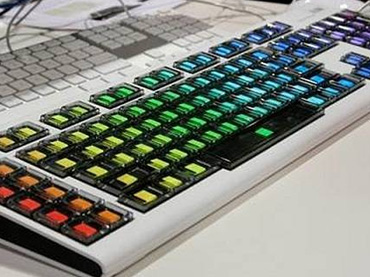The Optimus Maximus OLED keyboard has captured the attention of techies around the world since its release back in 2008 by Russian design company Art. Lebedev Studio. This $1,500 keyboard’s main cut above the rest in the market is a set of OLED keys that change according to what the users set on its personalized software. Needless to say, despite the limited one-year run this innovative piece of technology had, it drew several curious crowds but was it even worth the buy?
For those who were not able to get your hands on the Optimus Maximus keyboard, here are the top ten things you should know about it:
Scroll down for video
[media-credit name=”Art Lebedev” link=”http://www.artlebedev.com/” align=”aligncenter” width=”640″] [/media-credit]
[/media-credit]
1. It is not your average typing keyboard
First off, the Optimus Maximus keyboards cost a whooping $1,500 so it’s unlikely that people purchase this for something as trivial as typing. Programmers are part of the demographic that can take advantage of it, as the keys can be adjusted to a certain computer language. The way this particular keyboard is designed does not make it suitable for the average user, it is bulky for one thing and the keys are known to be very loud. The keyboard’s size also too wide to fit in a computer table.
Each individual key is flat, making it difficult to type as well. So don’t expect this to be a keyboard you can type a 100 words per minute in.
2. The OLED display does its job
Organic light-emitting diode or OLED technology is applied on each of the 100+ keys of the Optimus Maximus keyboard, so users can expect it to shine as brightly as possible. But what makes this such a cutting edge design is the fact that users have the freedom to customize each key through a fully functional software.
3. The OLED keys display just about everything
As stated, the keyboard is unique because it can customize to display anything you can think of, from hieroglyphics to even a whole movie can display on your screen. All you need to do is to install the software to be able to configure these images to the Optimus Maximus.
[media-credit name=”Gizmodo” link=”http://gizmodo.com/” align=”aligncenter” width=”640″] [/media-credit]
[/media-credit]
[dfp1]
4. Do not expect it to be wireless
The Optimus Maximus keyboard has one wire attached to your computer and a separate AC adapter.
5. It is not portable and inconveniently large
Its size may as well come as its advantage, as the keyboard does have a sturdy design. But then again, with its price tag, you’ll still need to be extra careful when it comes to using it.
 Gizmodo
Gizmodo
6. This device is not plug-and-play
The whole custom keyboard thing does not happen in an instant. To get the most of this keyboard, you are going to have to program all the animations yourself. That means you’ll need a few hours to familiarize yourself with the software beforehand, and that doesn’t include the time needed to design the images you want to place on each key. So expect the whole process to be very time-consuming, especially when you don’t have any previous tech experience.
7. This model was customizable
During the time of its run, Art. Lebedev Studio had a lot of fixes to ensure its buyers they got their money’s worth. Unfortunately, it has stopped production completely and issues such as memory leak and the ability to simulate a series of keys when hitting a button have remained unfixed and not released as a feature respectively.
[media-credit name=”Tech Crunch” link=”http://techcrunch.com/” align=”aligncenter” width=”640″] [/media-credit]
[/media-credit]
[dfp2]
8. Don’t expect the OLED display to fill the entire key
The picture you set fills up approximately 85 percent of your OLED key with the exception of the Shift, Enter, or Space key since it gets understandably smaller there. This may not be a big deal, but it can disappoint users who were expecting their images to fill in the whole screen, so it is best not to be fooled by the early marketing photos released.
9. There are four variation of the Optimus Maximus
The four variations include one with only the space bar active (price: $462), one with the 10 side function keys active (price: $599), one with the 47 regular QWERTY keys active (price:$999), and one with all 113 keys active (price: $1564). If you want to buy secondhand models, users recommend the 10 side function keys since the others are not worth the expensive price.
10. The Optimus range has been completely discontinued
On the year 2014, Art Lebedev announced that they would discontinue the Optimus range. The only existing one is the Optimus Popularis, which utilizes a large LCD screen under a transparent keyboard instead of individual OLED displays. Even during its release, the Optimus Maximus failed to get favorable reviews, and much of the hype that was built around it was forgotten after users openly discussed its flaws.
[media-credit name=”WIRED” link=”http://www.wired.com/” align=”aligncenter” width=”640″] [/media-credit]
[/media-credit]
A $1,500 price tag for a keyboard is definitely not for the average user, and as impressive the concept may have been for the Optimus Maximus, it definitely should have been a work in progress. For those who are still interested with products that boast OLED technology, rumor has it that tech giants Apple are planning to incorporate it in their new Macbook design.
Watch the video below
[video1]



